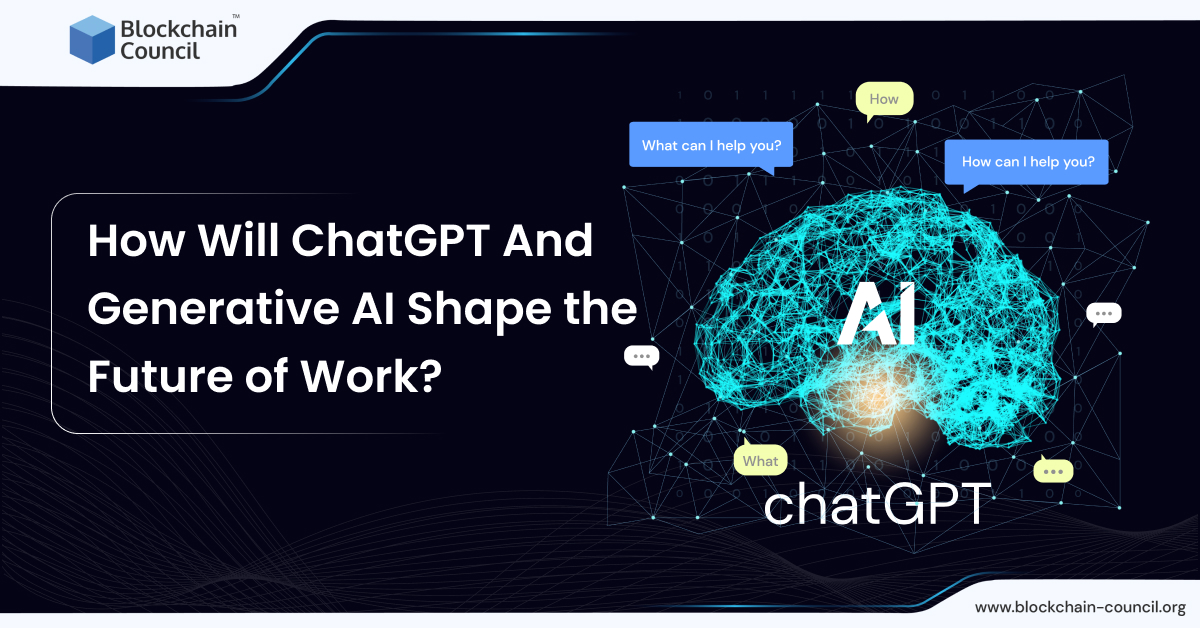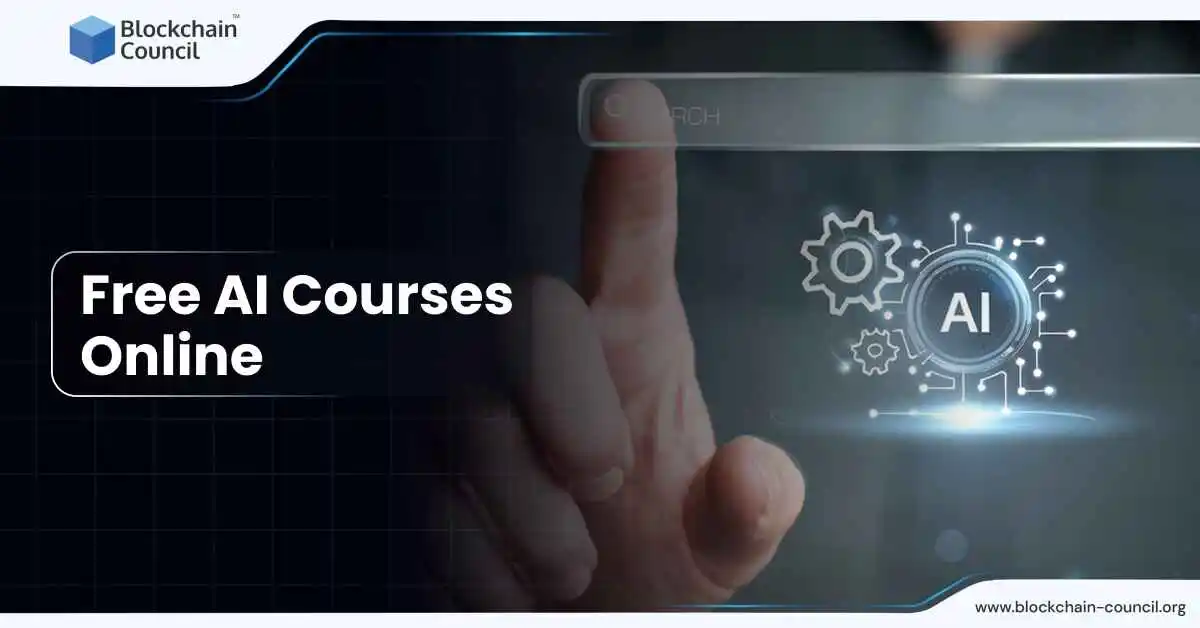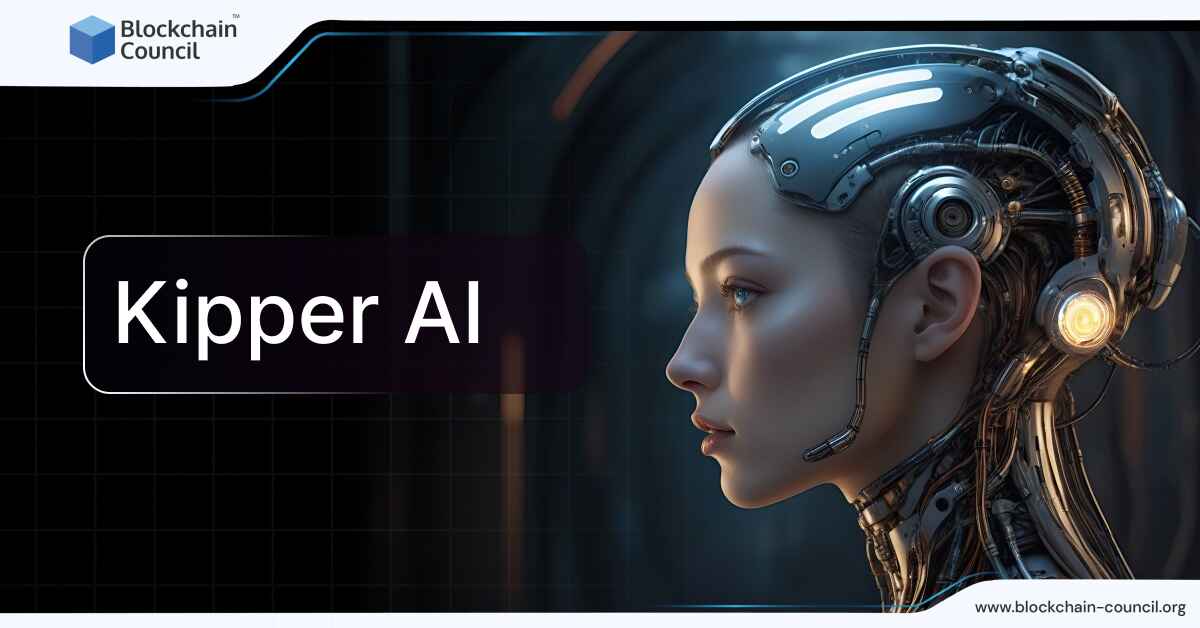
- Blockchain Council
- September 22, 2023
Summary
- Generative AI technologies, including ChatGPT, are expected to significantly increase productivity, with 80% of the US workforce potentially automating 10% of their tasks using Generative AI.
- ChatGPT, a natural language processing AI, is set to reshape the future of work by improving communication and automating various tasks.
- Generative AI, like ChatGPT, operates on machine learning and deep neural networks to create content, streamlining customer support and data analysis.
- Remote work is on the rise, with 12.7% of full-time employees already working from home, and 28.2% adopting hybrid models.
- Employers are adapting to remote work trends, with 93% planning to continue remote job interviews, showing a shift in how businesses operate.
- ChatGPT can automate tasks like drafting emails and answering customer queries, liberating employees from repetitive work.
- AI assists decision-making by sifting through data, providing real-time insights, and reducing errors in various industries.
- ChatGPT, a generative AI model, excels in natural language understanding, context analysis, and multilingual support.
- Generative AI has applications in customer support, content generation, language translation, research assistance, and more industries.
- Challenges in AI adoption include computing power, interpretability, ethics, and potential job displacement, but upskilling is essential to thrive in this AI-enhanced future of work.
Introduction
Generative AI (GAI) technologies, including ChatGPT, are poised to revolutionize the way we work, and the evidence is compelling. A significant 47% of US executives firmly believe that integrating generative AI will substantially boost productivity. Furthermore, OpenAI’s report indicates that 80% of the US workforce could see at least 10% of their tasks automated by Generative AI. This means a significant transformation is on the horizon, impacting a vast majority of professionals,
But do you know how ChatGPT and Generative AI are transforming the future of work? Understanding these technologies is essential as we navigate the transformative journey they are paving for the future of work. The potential benefits of AI in the workplace also come into sharp focus, with 60% of respondents anticipating that AI will streamline tasks, allowing them to redirect their efforts towards more strategic initiatives.
So, let’s figure out through this article, how ChatGPT and Generative AI are transforming the future of work!
What is ChatGPT?
ChatGPT is an advanced AI technology designed to facilitate human-computer interactions through natural language. It is part of the broader field of Generative AI and has garnered significant attention for its role in reshaping the future of work.
At its core, ChatGPT is a language model, a sophisticated software program trained on vast datasets containing text from the internet. This enables it to understand and generate human-like text, making it a valuable tool for a wide range of applications.
In the context of the future of work, ChatGPT has the potential to revolutionize how we communicate, collaborate, and automate tasks. It can be integrated into various platforms and systems to provide instant responses and assist with a multitude of tasks.
Understanding Generative AI
Generative AI is a subset of artificial intelligence that focuses on the creation of content, whether it be text, images, or even music, that is generated by a machine rather than a human. It operates on the principles of machine learning and deep neural networks, allowing it to generate highly realistic and contextually relevant outputs.
Generative AI models like ChatGPT are trained on extensive datasets and can generate coherent and contextually appropriate responses. This ability is what makes them so valuable in the context of the future of work.
In practical terms, Generative AI can automate content creation, streamline customer support through chatbots, and assist with complex data analysis. It has the potential to boost productivity, enhance customer experiences, and free up human workers to focus on more creative and strategic tasks.
Also Read- Top 10 Use Cases Of AI In Blockchain You Need To Know
The Current State of Work
Traditional Work Environments
Traditional work environments, characterized by cubicles and office desks, are gradually giving way to a new paradigm. As of 2023, statistics show that 12.7% of full-time employees are already working from home, with an additional 28.2% adopting a hybrid work model. While remote work is on the rise, it’s noteworthy that the majority, about 59.1%, are still based in physical offices.
Employers have been compelled to rethink their approach to work due to changing employee preferences and the efficiency gains enabled by technology. The desire for remote work is evident, as a staggering 98% of workers have expressed their wish to have at least partial remote work arrangements.
From the employers’ perspective, remote work is here to stay. An astonishing 93% of employers plan to continue conducting job interviews remotely. This shift is indicative of a broader transformation in how businesses operate, tapping into the power of AI-driven tools for recruitment and management.
Remote Work Trends
Now, let’s delve into the latest trends in remote work for 2023, which shed light on the future landscape of work:
- Adoption of Remote Work: The adoption of remote work is on the rise, with 12.7% of full-time employees currently working from home, and 28.2% embracing hybrid models. However, the majority still work in traditional office settings.
- Future of Remote Work: Looking ahead, it’s estimated that by 2025, approximately 32.6 million Americans will be working remotely, constituting about 22% of the workforce. This projection underscores the enduring impact of remote work.
- Preference for Remote Work: The desire for remote work is exceptionally high, with 98% of workers expressing their willingness to work remotely, at least part of the time.
- Employers’ Perspective: Employers are aligning with this shift, as 93% plan to continue conducting job interviews remotely. This indicates a long-term commitment to leveraging technology for hiring and management.
- Fully Remote Companies: Some companies have fully embraced remote work, with 16% operating entirely in this mode. This move is driven by the realization that productivity and talent know no geographical boundaries.
- Gender Gap in Remote Work: While remote work is prevalent across genders, there are some disparities. Specifically, 38% of men work remotely full-time, compared to 30% of women. These statistics highlight the need for addressing gender-related challenges in remote work.
- Preference for Remote Work Over More Compensation: It’s interesting to note that many employees are willing to trade some of their compensation for the opportunity to work remotely. This attests to the value people place on the flexibility and work-life balance it offers.
- Increasing Trend of Freelancers: The workforce landscape is also witnessing a surge in freelancers, with nearly half (47.00%) of workers globally opting for self-employment. This trend underscores the growing preference for autonomy and diverse work arrangements.
As we navigate this transformative era, it’s clear that remote work is not just a temporary response to global events but a fundamental shift in how we approach work. Organizations are adapting by integrating AI, like ChatGPT, to streamline processes, improve communication, and foster a sense of connection among remote teams.
Also Read- How Can Blockchain Developers Use AI? A Complete Guide
The Role of AI in the Workplace
Aspect of AI in the Workplace | Impact |
Task Automation | Increases efficiency by handling repetitive tasks. |
Decision Support | Provides data-driven insights for better decision-making. |
Augmented Creativity | Frees up time for creative and strategic work. |
Customer Service Enhancement | Offers 24/7 support through AI-driven chatbots. |
Data Analysis | Processes vast datasets quickly, extracting valuable insights. |
Personalized Marketing | Customizes marketing messages based on user behavior. |
Employee Training | Delivers personalized training modules for skill development. |
Predictive Maintenance | Identifies equipment maintenance needs, reducing downtime. |
Inventory Management | Optimizes stock levels, reducing excess or shortage issues. |
Automation and Efficiency:
One of the key aspects of AI in the workplace is automation. AI-powered systems can handle monotonous, time-consuming tasks with precision and consistency. This allows employees to focus on high-value, creative endeavors, increasing overall productivity.
ChatGPT, a state-of-the-art language model, takes automation to a new level. It can draft emails, generate reports, and even answer customer queries, all with remarkable accuracy. This liberates employees from mundane tasks, freeing them to tackle more strategic responsibilities.
AI-Assisted Decision Making:
In an era where data drives decision-making, AI provides invaluable assistance. ChatGPT’s natural language processing capabilities enable it to sift through vast amounts of data, extract insights, and present them in a digestible format. This empowers decision-makers with real-time, data-driven insights.
From marketing strategies to financial forecasting, AI-assisted decision-making is becoming the norm. Professionals can rely on AI systems to provide actionable recommendations, reducing the margin for error and increasing the chances of success.
ChatGPT: A Game Changer
What is ChatGPT?
As discussed earlier, ChatGPT is a cutting-edge example of generative AI, revolutionizing how we interact with technology. It’s an AI-driven language model designed to understand and generate human-like text based on the input it receives. ChatGPT stands at the forefront of natural language processing, shaping the future of work and communication.
Key Features and Capabilities
Feature / Capability | Description |
Natural Language Understanding | ChatGPT comprehends and generates human-like text, making it ideal for human-AI interactions. |
Contextual Understanding | It analyzes context, ensuring more coherent and meaningful conversations. |
Multilingual Support | Proficient in multiple languages, breaking down language barriers in global workplaces. |
Customization | Users can fine-tune ChatGPT’s behavior, adjusting tone and content generation to meet specific needs. |
Large Knowledge Base | Draws from extensive sources of information, providing accurate and up-to-date answers and insights. |
Scalability | Easily integrated into various applications, from simple chatbots to complex AI-driven systems. |
Efficiency | Enhances productivity by automating tasks, answering queries, and assisting with research. |
Real-World Applications
Application | Description |
Customer Support | Powers chatbots for 24/7 customer inquiry handling, ensuring prompt responses and improved satisfaction. |
Content Generation | Assists in generating blog posts, articles, and marketing materials quickly, saving time and resources. |
Language Translation | Facilitates seamless communication between individuals who speak different languages, bridging global language gaps. |
Research Assistant | Supports researchers by summarizing articles, generating hypotheses, and providing relevant information for faster discoveries. |
Personal Productivity | Helps with drafting emails, setting reminders, and managing schedules, increasing individual efficiency and organization. |
Healthcare | Analyzes medical records, offering valuable insights for doctors in diagnosis and treatment planning, ultimately improving patient care. |
Education | Supports online learning by answering student questions, generating educational content, and enhancing the learning experience. |
Generative AI in Action
Beyond ChatGPT: Other Generative AI Models
Generative AI, at its core, empowers machines to create content, images, and even code autonomously. ChatGPT, developed by OpenAI, is a prime example. It utilizes deep learning models to generate human-like text, making it a versatile tool for content creation, customer support, and more.
The magic behind ChatGPT lies in its neural networks. These networks analyze vast datasets, learning patterns and nuances of human language. As a result, it can draft articles, answer questions, and even craft personalized emails with remarkable accuracy.
But ChatGPT is just the tip of the iceberg. Other Generative AI models like GPT-4 and BERT are pushing the boundaries further. GPT-4, with its improved understanding of context, can simulate natural conversations, making it invaluable in chatbots and virtual assistants.
In the realm of image generation, DALL-E steals the spotlight. This AI can create images from textual descriptions, sparking creativity in graphic design and art. Moreover, models like Reinforcement Learning from Human Feedback (RLHF) are driving advancements in machine learning by learning from human interactions.
Examples of Generative AI in Various Industries
Industry | Application of Generative AI |
Healthcare | Drug discovery through chemical analysis |
Finance | AI-generated reports for data analysis |
Media and Entertainment | Personalized content recommendations |
Education | Interactive content generation for e-learning |
Graphic Design | DALL-E: AI generating images from text |
Customer Support | Chatbots providing instant and accurate responses |
Search Engines | BERT improving search result relevance |
Robotics | Enhanced decision-making in autonomous systems |
Benefits of Using ChatGPT and Generative AI
Benefits | Description |
Enhanced Content Creation | Generative AI like ChatGPT can create high-quality content quickly, saving time and effort for writers and marketers. |
Improved Customer Support | ChatGPT-powered chatbots offer 24/7 support, answering customer queries efficiently and increasing customer satisfaction. |
Personalized Recommendations | Generative AI can analyze user data to provide personalized recommendations, enhancing user experiences in e-commerce and entertainment. |
Data Analysis and Insights | AI models can process and analyze vast datasets, providing valuable insights and aiding decision-making in various industries. |
Automation of Routine Tasks | Generative AI can automate repetitive tasks, freeing up human resources for more complex and creative work. |
Natural Language Understanding | AI models understand context and nuances in language, enabling more human-like interactions in chatbots and virtual assistants. |
Creative Content Generation | Models like DALL-E can generate images and artwork from textual descriptions, fostering creativity in design and art. |
Advances in Research | Generative AI models contribute to advancements in machine learning and AI research, pushing the boundaries of what’s possible. |
Challenges and Concerns
As businesses adopt AI-driven solutions, several challenges emerge. One key concern is the need for substantial computing power to support these advanced models. Ensuring accessibility for businesses of all sizes is vital to democratize AI.
Furthermore, the interpretability of AI-generated content remains a challenge. Understanding how and why AI systems produce certain outputs is crucial for trust and transparency. Researchers are actively working on making AI decision-making more interpretable.
Ethical Considerations
Ethics plays a pivotal role in AI development and deployment. Ensuring that AI systems are unbiased and fair is paramount. Developers must avoid reinforcing existing biases in the data used to train these models.
Moreover, privacy concerns arise as AI systems process vast amounts of data. Protecting sensitive information and adhering to data privacy regulations is a constant priority. Striking a balance between innovation and privacy is an ongoing ethical dilemma.
Potential Job Displacement
One of the most discussed aspects of AI adoption is its potential impact on the job market. While AI can automate routine tasks, it also creates new opportunities. Jobs that require creativity, critical thinking, and emotional intelligence remain largely immune to automation.
To mitigate job displacement, reskilling and upskilling programs are essential. Empowering the workforce with AI literacy and digital skills is crucial for a smooth transition into the AI-powered future.
Data Privacy Concerns
The surge in data usage within AI systems raises significant data privacy concerns. Protecting user data and ensuring it’s not exploited is a top priority. Regulations like GDPR and CCPA have been enacted to safeguard personal information.
Companies must implement robust data security measures, including encryption and access controls, to prevent data breaches. User consent and transparency regarding data usage are also critical in maintaining trust.
Also Read- Top 5 Certifications And Courses To Learn About Generative AI
Industries Embracing ChatGPT and Generative AI
Industry | Applications and Statistics |
Drug Design | Accelerates drug discovery, reduces costs and timelines. |
Material Science | Creates materials with specific properties for various sectors. |
Chip Design | Optimizes semiconductor chip component placement, reducing development time. |
Marketing and Media | By 2025, 30% of outbound marketing messages from large organizations will be synthetically generated, up from less than 2% in 2022. |
Film Industry | By 2030, a major blockbuster film will be released with 90% of the film generated by AI. |
Healthcare | Predicts disease progression, personalizes treatment, aids in drug development. |
Manufacturing | Optimizes production processes, quality control, aids in product design. |
Retail | Personalizes customer experiences, optimizes inventory, predicts sales trends. |
Financial Services | Improves risk assessment, automates financial planning, detects fraud. |
Banking | Potential annual value addition of $200 billion to $340 billion when fully implemented. |
High Tech | Adds value equivalent to as much as 9% of global industry revenue for tech companies. |
Pharmaceuticals and Medical Products | Potential value addition of up to 5% of industry revenues. |
Education | Could add value equivalent to up to 4% of global industry revenue. |
The Importance of Training and Education
Till now you already know how ChatGPT and Generative AI are transforming the future of work. To thrive in this digital landscape, upskilling yourself is crucial. That’s where ChatGPT certification and Generative AI certification comes into play.
Certification | Description | Duration | Validity | Exam | Access Mode |
Certified AI Expert™ | Beginner-friendly AI program covering core concepts. | 6 Hours | Lifetime | Online | Self-paced |
Certified Generative AI Expert™ | In-depth training in generative models and advanced AI techniques. | 7 Hours | Lifetime | Online | Self-paced |
Certified Prompt Engineer™ | Focus on prompt engineering for precise AI responses. | 6 Hours | Lifetime | Online | Self-paced |
Certified ChatGPT Expert | Mastery of ChatGPT technology for various applications. | 7 Hours | Lifetime | Online | Self-paced |
The aforementioned ChatGPT certification and Generative AI certification by the Blockchain Council will equip you with the necessary skills to shine in a future where ChatGPT and Generative AI is transforming the future of work!
Challenges and Opportunities for Job Seekers
- New Job Roles: The infusion of Generative AI is ushering in a wave of fresh job roles. At the helm of this transformation are positions like Chief AI Officer, signaling the increasing importance of AI in organizational strategies. This is in line with the global artificial intelligence market, valued at a staggering 207 billion USD, highlighting the immense potential of AI technologies in creating these new roles.
- Impact on Hiring: Candidates are already leveraging tools like ChatGPT to craft compelling cover letters and impressive CVs. This democratization of writing skills empowers individuals who may not have previously possessed top-tier writing abilities. As Generative AI continues to advance, it may revolutionize the traditional approach to job applications, potentially shifting recruiters away from
- Resistance and Adoption: While some roles, such as graphic designers, programmers, and blockchain developers, may initially resist the emergence of Generative AI, they are likely to adopt AI tools that enhance their productivity and streamline their processes.
- Automation of Jobs: Generative AI is poised to take on various tasks, including those within customer service. Chatbots demonstrate remarkable efficiency in this arena, raising questions about the future of these roles and the skills required in this evolving landscape. Notably, automation could reshape 25% of jobs in the U.S. and Europe, with professions like attorneys and administrative workers facing the highest risk of job displacement.
- Impact on White-Collar Jobs: Higher-earning occupations, such as language, literature, history teachers, legal services, finance, insurance, and accounting, may experience substantial changes due to Generative AI. Understanding these shifts and adapting skill sets will be crucial for professionals in these fields.
Conclusion
In conclusion, the landscape of work is rapidly evolving, and at its forefront are transformative technologies like ChatGPT and Generative AI. From simplifying everyday tasks to revolutionizing customer interactions, these advancements have left an indelible mark on industries across the board.
For beginners entering the world of AI and seasoned professionals looking to harness its power, it’s clear that understanding and incorporating ChatGPT and Generative AI is essential. These tools empower us to work smarter, not harder, by automating repetitive tasks, enhancing creativity, and improving decision-making processes.
Now that we know how ChatGPT and Generative AI is transforming the future of work, it is important to upskill yourself with ChatGPT certification and Generative AI certification like the Certified ChatGPT Expert and the Certified Generative AI Expert™ certifications by the Blockchain Council. The future is here, and it’s an exhilarating ride towards a more AI-enhanced, yet human-centric, future of work.
Frequently Asked Questions
- ChatGPT is an AI technology designed for natural language interactions.
- It’s part of Generative AI, focusing on generating human-like text using machine learning.
- Generative AI automates content creation, streamlines customer support through chatbots, and assists with data analysis.
- It enhances productivity, improves customer experiences, and frees up humans for creative tasks.
- 12.7% of full-time employees work from home, and 28.2% use a hybrid model.
- By 2025, an estimated 22% of the workforce will work remotely.
- ChatGPT automates tasks like drafting emails and answering customer queries.
- Generative AI can assist in content generation, data analysis, and personalized marketing.
- Challenges include the need for computing power, interpretability of AI-generated content, ethical considerations, and potential job displacement.
- Protecting data privacy and ensuring fairness in AI systems are crucial concerns.





































































 Guides
Guides News
News Blockchain
Blockchain Cryptocurrency
& Digital Assets
Cryptocurrency
& Digital Assets Web3
Web3 Metaverse & NFTs
Metaverse & NFTs
